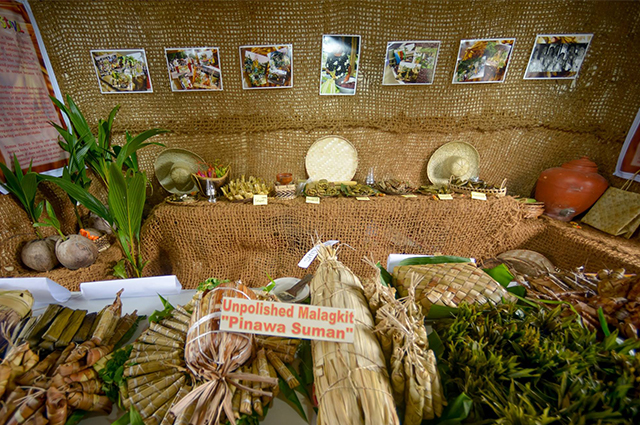 Eight of the best suman makers in Aurora competed during the Farmers’ Day, in what was to be their first official attempt at using unpolished or “brown” rice in creating the best tasting suman, 15 February.
Eight of the best suman makers in Aurora competed during the Farmers’ Day, in what was to be their first official attempt at using unpolished or “brown” rice in creating the best tasting suman, 15 February.
“Every year, the local government holds a Pinaka Contest. This 2016, we are holding the Pinakamasarap na Brown Rice Suman as suman is one of the most sought-after delicacy that visitors and tourists buy in Aurora. It is also in response to the call of the Department of Agriculture (DA) to eat brown rice,” said Venecia B. Estacio, focal person for organic agriculture and high value crops.
Suman is a steamed rice cake wrapped in fresh coconut palm or banana leaves. A native delicacy made with glutinous rice, coconut milk, sugar, and salt, suman has become a staple in typical Filipino fiestas.
“In our promotion of organic farming, we have heard farmers and non-farmers alike express their growing concern for their diet and health. We also note that their awareness and demand for pinawa or brown rice is increasing. Hence, the twist in our suman-making contest, “Estacio added.
Brown rice is the common term for the whole grain form of any kind of rice. It still has the bran, the part that is removed during polishing to make rice white. Thus, its brown color. Because of the bran, brown or unpolished rice has more protein, dietary fiber, minerals, antioxidants, B vitamins, and vitamin E compared to white rice.
“We want to make Filipino rice consumers healthier through the promotion of unpolished or brown rice. Since Filipinos also eat rice during snacks, we also want to develop and promote rice-based food products made of brown rice. Hence, the event,” explained Hazel V. Antonio, Be RICEponsible campaign director.
The Be RICEponsible Campaign of DA, has since 2014, been raising awareness as well as improving the consumption and production of brown rice in the Philippines. The promotion of brown rice is one of its pillar messages in making Filipinos responsible rice consumers.
“Junk foods are sold almost everywhere. We need to promote healthier alternatives to these like brown rice suman for snack and breakfast to nourish our children [and people] better,” said Eleanor De Mesa-Olivar, tourism officer and co-chair of the Suman House exhibit.
Farmers’ associations and rural improvement clubs from the eight municipalities of Aurora joined the contest: Baler, Casiguran, Dilasag, Dinalungan, Dingalan, Dipaculao, Maria Aurora, and San Luis.
San Luis’ milky soft suman bagged first place, taking home P10,000, followed by the latik-laden entry of Maria Aurora with P7,000, and the cheesy variant of Baler with P5,000.
Reviving lost tradition
The recently erected mini Suman House, a two-storey wooden hut decked with colorful suman-shaped decorations and other indigenous embellishments reminiscent of the Pahiyas of Quezon province, served as the venue for the taste off.
“We are pouring efforts to showcase Aurora’s suman-making heritage not just for the sake of marketing but to inspire community participation in helping revive the Suman Festival, which we last held in 2004,” Olivar added.
From 1997 to 2004, Aurora is home to the grand celebration of the Suman Festival, which also coincides with the province’s founding anniversary.
It is believed that the suman of Aurora started even before the Japanese came. Travelers from Nueva Ecija and Manila, journey from three to five days by walking or riding on a horse. This long journey entailed extra work like bringing food that would keep them full while traveling. This triggered the preparation of suman, which was easy to bring and less perishable.
Healthier, taste even better
“All the pinawa suman tasted so good that you can hardly say that the makers used unpolished rice. I think they even tasted better than all the suman (made with polished rice) I have ever tasted,” remarked Antonio.
Lydia Amatorio, a contestant from Baler, said that although pinawa required more time to cook, it has a natural flavor that makes the resulting product taste better than that made with polished glutinous rice.
“The secret to making a milky rich and soft suman is in the soaking and amount of coconut milk used,” Melba Eberio, the master cook from the winning San Luis team.
“If unpolished glutinous rice will become accessible, it is possible for us to use it regularly for our suman,” Eberio added.
Meanwhile, suman maker Josie Mambalo of Brgy. Suguit, Maria Aurora has already begun selling brown rice suman to her clients on a made-to-order basis since their cooperative acquired a brown rice milling unit in 2015.
The Pinakamasarap na Brown Rice Suman Contest was organized by the local government of Aurora in partnership with the Be RICEponsible Campaign of DA.






